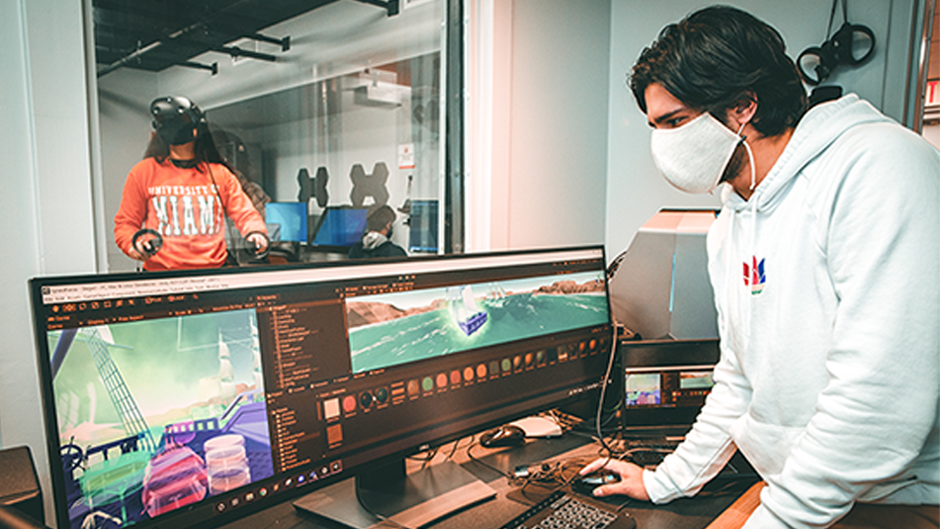For decades, virtual and augmented reality have been the subject of science fiction television and movies such as Star Trek, Minority Report, and The Matrix. In these experiences, people interact with virtual environments, characters, data, and other humans—represented through computer-generated images.
Today, University of Miami students are creating these experiences using headsets such as the Magic Leap One, Microsoft Hololens, and Meta Oculus Quest.
The University of Miami was quick to leverage extended reality to further its mission of serving the larger community with innovations in communication, education, healthcare, and work.
In 2019, under the leadership of Provost Jeffrey Duerk, the chief academic officer and executive vice president for academic affairs, the University launched the XR Initiative to further position itself as a leader in immersive technology. This initiative provides faculty with grants that they can use to begin exploring extended reality as a way to teach, conduct research, and create new ways to use data for advanced medical treatments.
Dr. Jacqueline Travisano, the University’s executive vice president for business and finance and chief operating officer, was instrumental in the creation of the UMIT Innovate team and continues to support the team’s many initiatives. The Innovate team hires and trains students to build XR experiences for faculty who have received funding from the Provost’s XR Initiative. As part of their employment on the Innovate team, students learn high-demand skills such as 3D modeling, Unity programming, and Agile project management skills that complement the degrees they earn through the University.
Via this joint effort, schools and colleges across the University have used this new technology in unprecedented ways to provide their students with a truly immersive educational experiences.
For example, the Sacred Spaces in the Age of Virtual Reality and Artificial Intelligence course is a combined effort of faculty in Religious Studies, Architecture, and Interactive Media. In this course, students explore the intersection of culture, spaces, and interaction through the Meta Oculus Quest headsets.
The School of Communication utilizes immersive media in the form of short films shot in virtual reality. One such film enabled students to walk around a Syrian refugee camp thousands of miles away.
One student developed an application that allows users to overcome language barriers by augmenting reality with subtitles during conversations with foreign-language speakers.
Microsoft recently invested in the digital transformation taking place at the University—providing additional augmented reality headsets and new experiences for students and staff to learn enhanced programming skills.
Since its creation, Innovate has delivered over 20 projects for the University of Miami, obtained hundreds of thousands of dollars in grants in support of its work, and created applications to support engineering education, medical visualizations, and crisis scenario training, advancing the University’s teaching, innovation, research, and service mission.
“It’s a symbiotic exchange—students benefit by learning new, high-demand skills while the University advances groundbreaking discoveries and leading-edge inventions,” said Allan Gyorke, chief academic technology officer.
Innovate has demonstrated value to the University, physicians, faculty, and the larger community. Max Cacchione, the director of innovation at UMIT, notes the opportunity this program presents to students:
“Technology has the potential to be a great equalizer,” Cacchione said. “In this program, we have students from all types of communities, with over half of the students coming from low-income backgrounds. What unites them is a shared passion and drive to use the opportunities they have at the U to make a difference.”
Technology can remove traditional barriers for students to find success, in part because of the wide availability of digital resources accessible online to support success and the proliferation of digital recruiting platforms creating large virtual networks and algorithms that identify talent on hiring platforms.
“Students interested in joining the Innovate team usually have a basic understanding of coding, but we expand upon that knowledge to teach students the most up-to-date languages and technologies so that they can graduate with greater employment opportunity,” Cacchione said. “Upon graduating, students will have a displayed performance working on a software development team with a robust project portfolio in a high demand field.”
Students have already started using the program to find competitive jobs with top tech companies after graduation. Recent alumni have received job offers from Samsung, Amazon, Apple, and Meta (formerly known as Facebook).
Industry reports support these findings, with demand for 3D graphics and real-time 3D training growing 601% faster than the market overall, according to Burning Glass, which offers comprehensive labor market analytics and economic data.
Innovate is just one of many steps the University is taking to further advance scientific discovery and improve health outcomes. These are key initiatives of the University of Miami’s Ever Brighter: The Campaign for Our Next Century, which is set to conclude in 2025 with the University’s centennial.
Learn more about UMIT Innovate and its work. [BUTTON]

